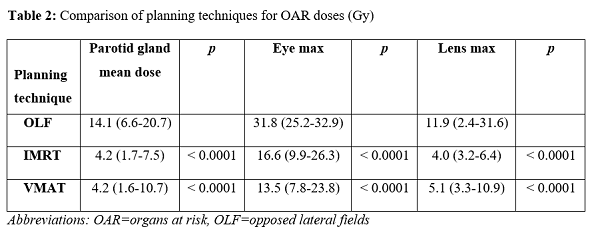43 patients who received previous WBRT were replanned. In OLF, protocol
violation was observed in all patients for parotid glands and eye doses, in 28 (65%)
for lens max doses. No patients achieved parotid max < 30 Gy. Mean parotid
gland V25 was 29.2% (7.8-52.4). Compared to OLF plans, both IMRT and VMAT plans
obtained significantly lower parotid mean doses, 14.1 (6.6-20.7), 4.2 (1.7-7.5)
and 4.2 (1.6-10.7), respectively (p<0.0001)
(Table 2). Same sparing benefit was seen for eye max and lens max doses. Mean
eye max dose was 31.8 (25.2-32.9) for OLF, 16.6 (9.9-26.3) for IMRT, and 13.5
(7.8-23.8) for VMAT, respectively (p<0.0001).
Mean lens max dose was 11.9 (2.4-31.6) for OLF, 4.0 (3.2-6.4) for IMRT, and 5.1
(3.3-10.9) for VMAT, respectively (p<0.0001).
Mean treatment time in OLF plans was 0.7 minutes. In IMRT and VMAT plans,
treatment duration was 3.9 min and 3.2 min, respectively.
